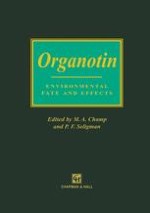1996 | OriginalPaper | Buchkapitel
Bioaccumulation of TBT by Aquatic Organisms
verfasst von : Roy B. Laughlin Jr
Erschienen in: Organotin
Verlag: Springer Netherlands
Enthalten in: Professional Book Archive
Aktivieren Sie unsere intelligente Suche, um passende Fachinhalte oder Patente zu finden.
Wählen Sie Textabschnitte aus um mit Künstlicher Intelligenz passenden Patente zu finden. powered by
Markieren Sie Textabschnitte, um KI-gestützt weitere passende Inhalte zu finden. powered by
Tributyltin (TBT) is accumulated by all taxa that have been examined. Typical tissue burdens range from undetectable levels to as high as 7 µg g-1 (wet weight). Molluscs, as a group, exhibit the highest tissue burdens and also the highest bioaccumulation factors (BAF). Some microorganisms are also notable accumulators, but in this case adsorption to the biofilm (predominantly polysaccharides) rather than sequestration within cells is an important mechanism of uptake. Crustaceans and fish generally accumulate lower burdens of TBT, probably because they possess enzymatic capability to degrade and excrete TBT. Bioaccumulation factors (BAF) as high as 50 000 have been reported, but the route of uptake (e.g. from water or food) was not necessarily differentiated during the experiment. Experimental studies have specifically examined uptake from water, where calculation of a bioconcentration factor (BCF) is appropriate. BCF values range up to 10 000. Both BAF and BCF values are higher than would be caused by partitioning processes alone. Binding is thus proposed as a mechanism that explains enhanced accumulation. A scheme to explain bioaccumulation is presented that proposes a role for (a) chemical speciation of butyltin with major anions in natural waters, (b) routes of exposure, (c) role for partitioning and binding to control both the kinetics of uptake and burdens in tissues, and (d) contribution of depuration mechanisms to control tissue burdens. Findings presented in this review support the use of biomonitors for TBT contamination, but the tissue burdens of TBT in biomonitors likely reflect a steady-state distribution of TBT in all compartments of the ecosystem rather than concentration in a single compartment (e.g. water). While the topical issue of tributyltin use diminished due to restrictions on its use, this compound provides several important opportunities as a model compound to increase understanding of bioaccumulation processes and environmental compartmentalization, in general. Some further studies may thus be warranted.
